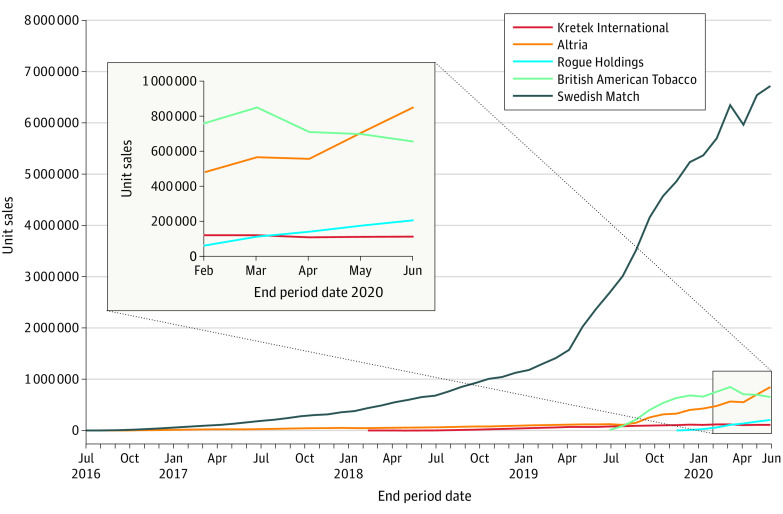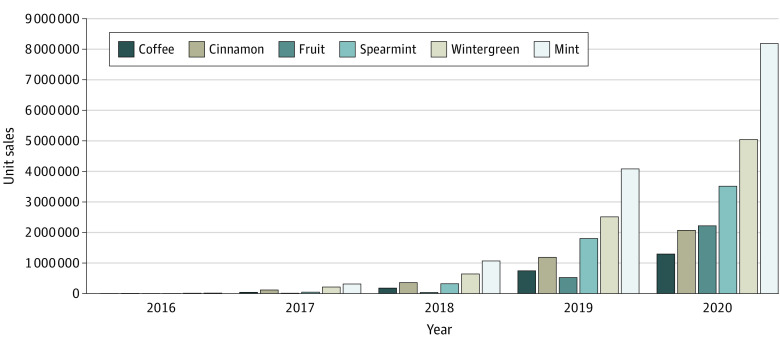Abstract
This study uses retail scanner data to assess nicotine pouch sales in the US between 2016 and 2020.
In 2016, a tobacco product commonly referred to as nicotine pouches entered the US market. These prefilled, microfiber pouches contain nicotine powder that dissolves in the mouth without requiring spitting. Nicotine pouches contain nicotine salts that deliver high levels of nicotine with less irritation than the free-base nicotine in most smokeless tobacco products.1,2 Nicotine is highly addictive, harms fetal development, and can harm brain development through age 25 years.3 Leading smokeless tobacco manufacturers sell nicotine pouches in varying strengths and flavors as the brands on! (Altria), Velo (British American Tobacco [BAT]), and ZYN (Swedish Match). Marketing materials describe the products as “tobacco-free,” “all white,” and more discreet and convenient than electronic and conventional cigarettes.2,4
The extent of nicotine pouch consumption is unknown. We assessed US nicotine pouch sales using retail scanner data.
Methods
Data for all US sales of nicotine pouches from March 27, 2016, through June 13, 2020, were licensed from the Nielsen Company for convenience, club, discount, and dollar stores; mass merchandisers; supermarkets; pharmacies; and military commissaries in the contiguous 48 states and Washington, DC. National-level unit and dollar sales for each universal product code (UPC) were provided in 4-week aggregates.
Nicotine pouch products were identified through external market research and review of UPC variables. One unit was defined as a container of (typically 15-20) nicotine pouches. Unit sales were aggregated by year, manufacturer, flavor, and venue. Shares of unit sales by manufacturer were calculated as a proportion of total unit sales. Dollar sales were inflation adjusted to 2020 dollars. Average monthly percentage change (AMPC) in unit sales and 95% CIs, by manufacturer and flavor, were calculated using Joinpoint version 4.8.0.1 (National Cancer Institute), a segmented regression analysis application. Statistically significant AMPCs did not cross 0.
Results
Nicotine pouch sales were observed among 5 manufacturers, with Swedish Match and Altria data first appearing in July and August 2016, respectively; Kretek International in February 2018; and BAT and Rogue in July and November 2019, respectively.
Nicotine pouch sales increased from 163 178 units ($709 635) in 2016 to 45 965 455 units ($216 886 819) during the January to June 13, 2020, period (July 2016–June 2020 unit AMPC, 10.9 [95% CI, 10.4-11.4]; Figure 1). Mint flavors (including spearmint and wintergreen) were most commonly sold across the study period. However, during the January 2019–June 2020 period, unit sales of fruit-flavored nicotine pouches (AMPC, 19.2 [95% CI, 14.2-24.5]) increased more rapidly than mint (AMPC, 10.1 [95% CI, 8.5-11.8]) and other nonfruit or nonmint flavors (AMPC, 9.3 [95% CI, 8.1-10.4]; Figure 2).
Figure 1. Nicotine Pouch Unit Sales in the US by Manufacturer, July 1, 2016–June 13, 2020.
One unit was defined as a container of (typically 15-20) nicotine pouches. As of November 2020, Dryft is sold under the Velo brand by British American Tobacco.
Figure 2. Mean Quarterly Unit Sales of Nicotine Pouches in the US by Flavor, 2016-2020.
One unit was defined as a container of (typically 15-20) nicotine pouches. Estimated from annual sales divided by quarters of data available. The fruit category includes Altria’s berry and citrus; British American Tobacco’s citrus; Kretek International’s black cherry, citrus, and dragon fruit; Rogue Holdings’ honey lemon and mango; and Swedish Match’s citrus. The mint category includes Altria’s and British American Tobacco’s mint, Kretek International’s peppermint, Rogue Holdings’ peppermint, and Swedish Match’s cool mint and peppermint. The spearmint category includes Kretek International and Swedish Match. The wintergreen category includes Altria, Kretek International, Rogue Holdings, and Swedish Match. The cinnamon category includes Altria, Kretek International, and Swedish Match. The coffee category includes Altria, Kretek International, and Swedish Match. Altria’s original flavor (0.015% of unit sales) was excluded because it did not fit within the aforementioned categories.
Swedish Match led unit share, peaking at 92.6% in July 2019. By June 2020, Swedish Match comprised 78.7% of unit share, followed by Altria (10.0%), BAT (7.6%), Rogue (2.4%), and Kretek International (1.3%). Convenience stores accounted for 97.7% of total sales.
Discussion
Sales of nicotine pouches have increased considerably since 2016. Convenience stores were the primary nicotine pouch sales venue, and Swedish Match led unit sales. However, during the COVID-19 pandemic, BAT reports “pivoting consumer activations into digital”5; additionally, a nicotine pouch e-commerce site reported 250% US sales growth during the January-June 2020 period.4
All tobacco products, including nicotine pouches, are regulated by the US Food and Drug Administration (FDA). Manufacturers of nicotine pouches are required to submit certain product information to the FDA, convey nicotine warnings, and comply with marketing restrictions.
Limitations of the study include that it could not assess purchaser age. Data may reflect sales to adults or direct or indirect sales to youth. Additionally, sales may be underestimated because data do not include e-commerce or tobacco specialty store transactions.
Noncombustible nicotine products might benefit nonpregnant adults if used as complete smoking substitutes.3 However, nicotine pouches have similar nicotine content to conventional tobacco products6; nicotine is addictive and poses significant health risks for young people.3 Moreover, nicotine pouches’ flavors and marketing for discreet use mirror e-cigarette marketing tactics known to attract nicotine-naive young people.1,3 Given the expanding range of tobacco products, clinicians should ask patients about any tobacco product use, including nicotine pouches.3
Section Editor: Jody W. Zylke, MD, Deputy Editor.
References
- 1.Gholap VV, Kosmider L, Golshahi L, Halquist MS. Nicotine forms: why and how do they matter in nicotine delivery from electronic cigarettes? Expert Opin Drug Deliv. 2020;17(12):1727-1736. doi: 10.1080/17425247.2020.1814736 [DOI] [PMC free article] [PubMed] [Google Scholar]
- 2.Robichaud MO, Seidenberg AB, Byron MJ. Tobacco companies introduce “tobacco-free” nicotine pouches. Tob Control. 2020;29(e1):e145-e146. [DOI] [PMC free article] [PubMed] [Google Scholar]
- 3.US Department of Health and Human Services . e-Cigarette use among youth and young adults: a report of the Surgeon General. Published 2016. Accessed May 14, 2021. https://e-cigarettes.surgeongeneral.gov/documents/2016_SGR_Full_Report_non-508.pdf
- 4.Nicokick website. Accessed January 13, 2021. https://nicokick.com/us/about-us/
- 5.British American Tobacco . British American Tobacco 2020 interim results transcript from presentation webcast and Q & A conference call on July 31, 2020. Accessed April 1, 2021. https://www.bat.com/group/sites/UK__9D9KCY.nsf/vwPagesWebLive/DOBUYN5F/$file/HY_2020_Presentation_Transcript.pdf
- 6.Stanfill S, Tran H, Tyx R, et al. Characterization of total and unprotonated (free) nicotine content of nicotine pouch products. Nicotine Tob Res. Published online May 26, 2021. doi: 10.1093/ntr/ntab030 [DOI] [PubMed] [Google Scholar]




